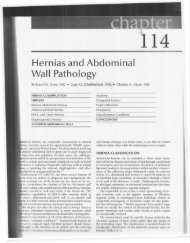Gore RM, Ghahremani GG et al. Anomalies and - Department of ...
Gore RM, Ghahremani GG et al. Anomalies and - Department of ...
Gore RM, Ghahremani GG et al. Anomalies and - Department of ...
Create successful ePaper yourself
Turn your PDF publications into a flip-book with our unique Google optimized e-Paper software.
a right upper quadrant mass. Gangrene develops in more than<br />
50% <strong>of</strong> cases <strong>and</strong> is extremely common when the pain has<br />
been present for more than 48 hours. On cross-section<strong>al</strong><br />
imaging, the g<strong>al</strong>lbladder is distended <strong>and</strong> may have an unusu<strong>al</strong><br />
location <strong>and</strong> show mur<strong>al</strong> thickening. The diagnosis is seldom<br />
made preoperatively, however.40.41<br />
Ectopic G<strong>al</strong>lbladder<br />
The g<strong>al</strong>lbladder can be located in a vari<strong>et</strong>y <strong>of</strong> anom<strong>al</strong>ous positions<br />
(Fig. 78-3). In patients with an intrahepatic g<strong>al</strong>lbladder,<br />
the g<strong>al</strong>lbladder is compl<strong>et</strong>ely surrounded by hepatic parenchyma.<br />
The intrahepatic g<strong>al</strong>lbladder usu<strong>al</strong>ly presents little<br />
difficulty in imaging, but it may complicate the clinic<strong>al</strong> diagnosis<br />
<strong>of</strong> acute cholecystitis because <strong>of</strong> a paucity <strong>of</strong> peritone<strong>al</strong><br />
signs resulting from the long distance b<strong>et</strong>ween the g<strong>al</strong>lbladder<br />
<strong>and</strong> peritoneum. This anom<strong>al</strong>y <strong>al</strong>so makes cholecystectomy<br />
more difficult. On sulfur colloid scans, the intrahepatic<br />
g<strong>al</strong>lbladder presents as a cold hepatic defect.<br />
The g<strong>al</strong>lbladder has <strong>al</strong>so been reported in the following<br />
positions: suprahepatic, r<strong>et</strong>rohepatic (Fig. 78-4), supradiaphragmatic,<br />
<strong>and</strong> r<strong>et</strong>roperitone<strong>al</strong>. In patients with cirrhosis,<br />
sm<strong>al</strong>l or absent right lobes, or chronic obstructive pulmonary<br />
disease, the g<strong>al</strong>lbladder tog<strong>et</strong>her with the colon is <strong>of</strong>ten<br />
interposed b<strong>et</strong>ween the liver <strong>and</strong> the diaphragm.42 Left-sided<br />
g<strong>al</strong>lbladders may occur in situs inversus or as an isolated<br />
finding. They can <strong>al</strong>so lie in the f<strong>al</strong>ciform ligament, transverse<br />
mesocolon, <strong>and</strong> anterior abdomin<strong>al</strong> w<strong>al</strong>l.<br />
ABNO<strong>RM</strong>ALITIES IN GALLBLADDER SIZE<br />
Cholecystomeg<strong>al</strong>y<br />
Enlargement <strong>of</strong> the g<strong>al</strong>lbladder has been reported in a numhcl<br />
<strong>of</strong> disorders including diab<strong>et</strong>es (because <strong>of</strong> an autonomic<br />
neuropathy) <strong>and</strong> after trunc<strong>al</strong> <strong>and</strong> selective vagotomy. The<br />
g<strong>al</strong>lbladder <strong>al</strong>so becomes larger than norm<strong>al</strong> during pregnancy,<br />
in patients witb sickle hemoglobinopathy, <strong>and</strong> ill<br />
extremely obese people.43-46<br />
Microg<strong>al</strong>lbladder<br />
In patients with cystic fibrosis, the g<strong>al</strong>lbladder is typic<strong>al</strong>ly<br />
sm<strong>al</strong>l, trabeculated, contra



